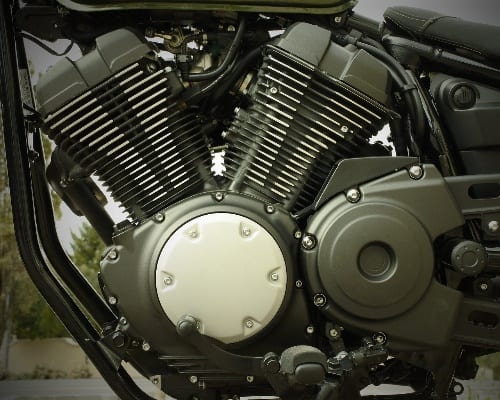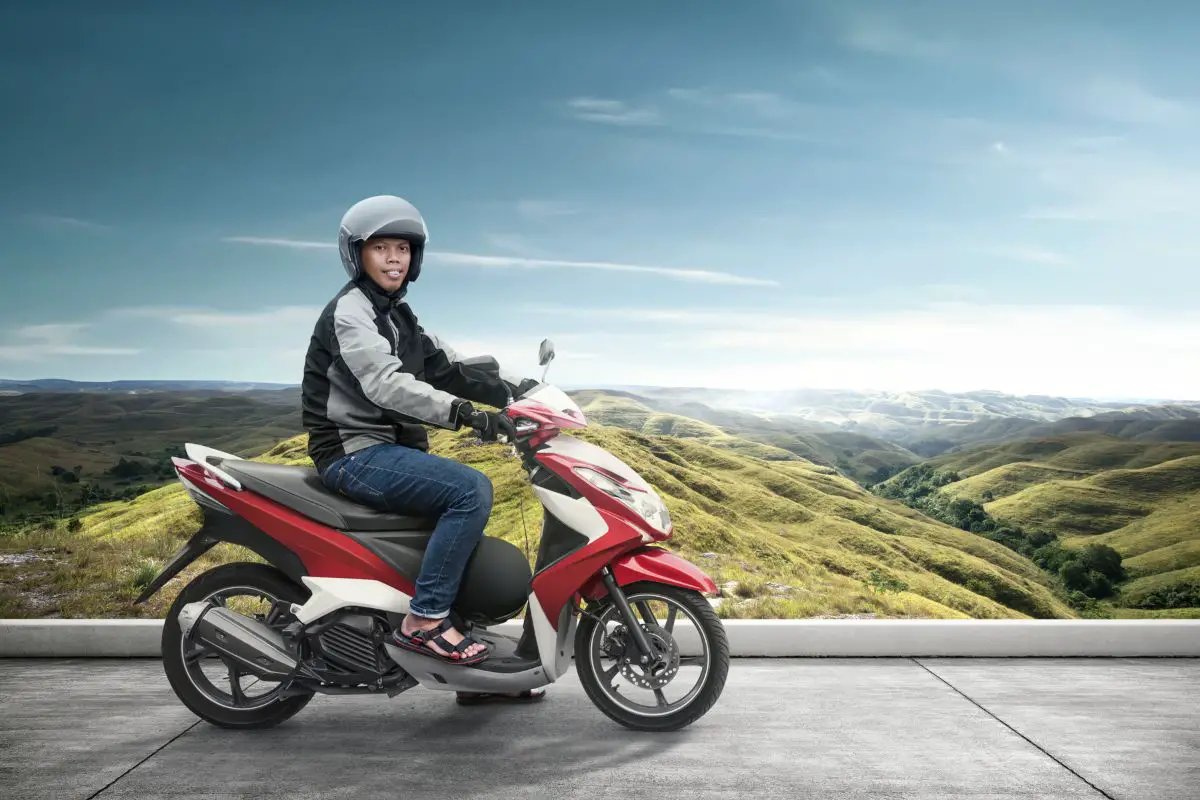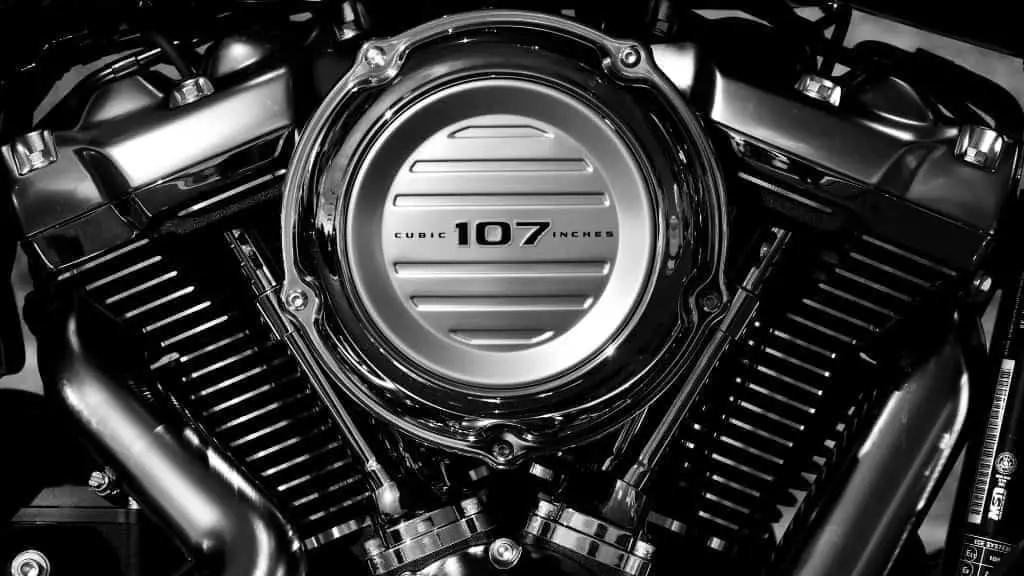
After reading this article, you will fully understand what motorcycle displacement is. I have included an easy to understand informative video as well.
I have also included a BHP to KW conversion Table
To explain what motorcycle displacement is, we have first to understand how an engine is built. Viewing a motorcycles engine from the side, you will see that it is grouped into 3 parts
- The cylinder head, which is the top part
- The Cylinder which is the second part (this is where the piston is located)
- The Crankcase and Gear Box makes up the third part (this is also where the crankshaft is located)
The part directly located under the cylinder is the crankcase, and the rest is the gearbox.
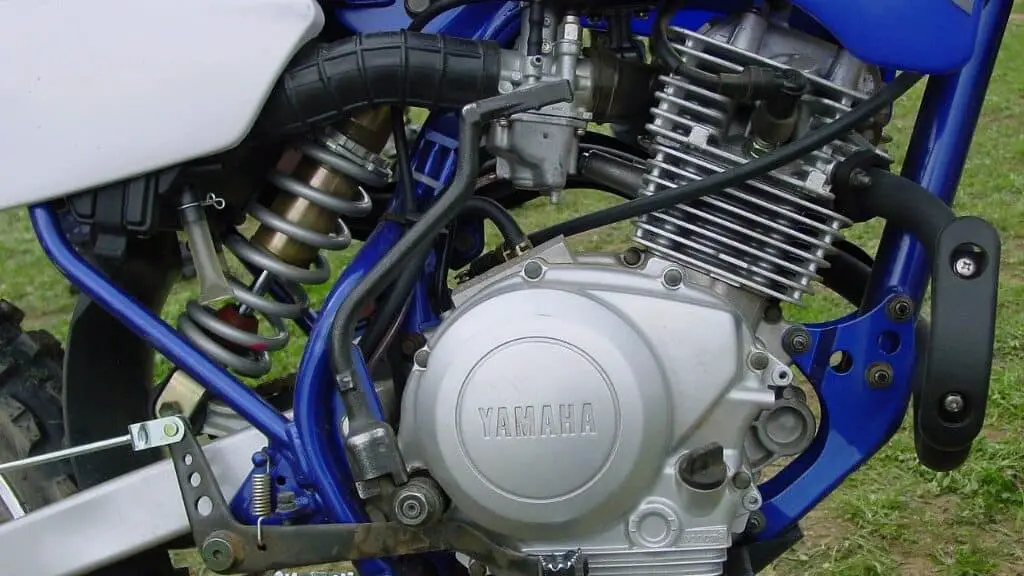
So, What is motorcycle displacement?
Motorcycle displacement is how much volume the piston displaces within the engine’s cylinder as it moves the crankshaft up and down and is referred to as the CC’s of the engine or Cubic Centimeters. The crankshaft then converts this up and down movement into a rotational movement producing the power.
If the engine is a two-stroke engine, this means that there are two steps the engine goes through to produce the power. A four-stroke engine would go through four steps to produce power.
The valves and camshaft are located within the cylinder, which is cylindrical in shape, so it is called the cylinder. The cylinder’s interior is made of cast aluminum, which has a steel cylinder wall or sleeve.
If you are reading this article because you are thinking of carrying out some maintenance on your motorcycle I use a really good motorcycle jack when I tinker with my bike. I have had my one for a good few years and can highly recommend it.
If you click HERE it will take you to Amazon where you can view the one I use.
Motorcycle Displacement and An Engines CC?
When the engine size of a motorcycle is described in CC, the CC refers to the engine cylinder size.
The cylinder’s volume or size is measured in cubic centimeters (cm3) or cubic inches (in3). The CC is a short abbreviation for a cubic centimeter or cubic capacity.
The engines CC is not the entire volume of the cylinder. As we have previously mentioned, there is a piston inside the cylinder.
This piston is connected to a shaft called the crankshaft, and when the engine is switched on and operating, the piston moves up and down within the cylinder or displaces the cylinder.
As the piston moves up and down, it pulls and pushes on the crankshaft, which in turn moves up and down, but as the bottom of the crankshaft is relatively round, it can convert this up and down movement into a rotational movement.
How much volume the piston displaces within the cylinder is the engine’s CC or the motorcycle engine’s displacement.
How Is An Engines CC Or Displacement Calculated?
The CC or displacement of an engine is calculated in the same way as you would any other cylindrical item.
We need to have the diameters measurement (or Bore measurement) and the height (or Stroke) measurement of the cylinder.
The height is measured from where the top of the piston stops within the cylinder when it is on its way up, which is also called the Top Dead Center, to the pistons lowest point when it makes its way to the bottom of the cylinder, which is also called the Bottom Dead Center.
This is where displacement happens. The formula for this calculation is Pi r2 h.
The cylinder volume formular is:
Pi r2 h
r = The radius (or half the diameter of the Bore)
h= The height or Stroke
So to calculate the cc of a particular engine, you would take Pi and multiply it with half the Bore width squared and multiply this by the height (The Stroke)
Here is an example below:
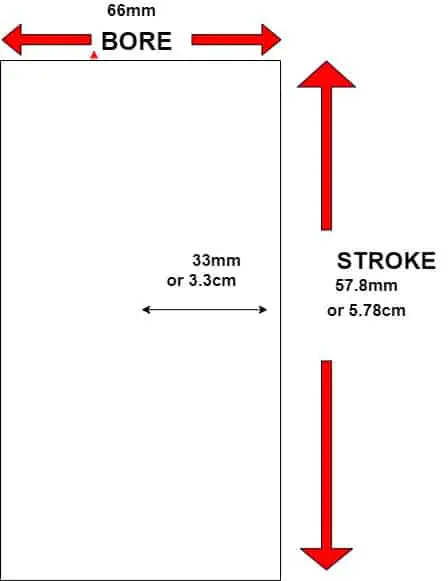
To calculate this engines displacement or cc:
Pi x 3.3 x 3.3 x 5.78 = 197.75 cm3
So this engine would be a 200cc
Minimal changes in the Bore and Stroke values will make a significant change in the displacement figure. In the diagram below, the Bore has increased by just 15mm.
So the caulculation now is:
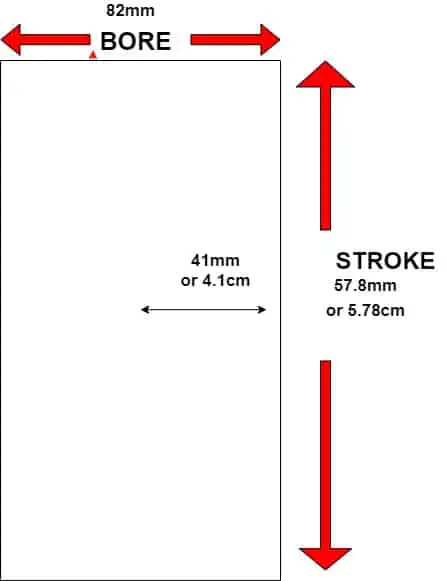
Pi x 4.1 x 4.1 x 5.78 = 305.24
So this engine’s size would be a 300cc
Although increasing the Bore size is the simplest way to increase an engine’s cc, there are limitations to this as reducing the steel sleeves thickness too much to gain the extra width will make the engine fail.
Another way to increase the cc of an engine would be to increase the cylinder’s height, otherwise called the stroke. However, to archive this, the crankcase diameter would need to be increased.
The actual power of an engine also increases by increasing the amount of engine displacement or cc. But this extra power is not achieved in all cases. The same cc engines can have different power outputs.
For example, a 200 cc engine could have a power output of 24bhp, and a 250 cc engine could have a power output of 21bhp, for example.
The cc of an engine is not the only thing that makes a difference to an engine’s power. Many other factors go into this.
There may also be more than one cylinder, which makes up an engine. To calculate the cc of an engine with more than one cylinder, you multiply the cylinder cc by the engine’s number of cylinders.
Related Information
What Is Motorcycle RPM? An Interesting Guide.
Many motorcycles have a display which shows how many revs the engine is producing at any one time.
So, what is rpm?
RPM is an abbreviation for Rotations Per Minute or Revolutions per minute. This is how many times the crankshaft rotates in one minute. When the piston moves from the bottom of the cylinder to the cylinder’s top, back to the cylinder’s bottom, the crankshaft would have completed one full rotation.
When buying a new motorcycle, many manufacturers include the specifications of the motorcycle. Included within this information is usually what the motorcycles maximum power is and at what RPM it is reached.
For example, the Honda Fireblade CBR1000RR-R has a maximum power of 160kw at 14,500 rpm.
So, when the engine’s pistons make the crankshaft rotate 14,500 times per minute, the engine can generate power of 214 bhp or 160kw.
How Do You Convert BHP to KW? A Helpful Guide.
Many motorcycle manufacturers give the power of their engines in brake horsepower. However, sometimes you may want to know what the equivalent is in Kilowatts.
So, how do you convert BHP to KW?
- Firstly, we need to know how many kilowatts equals one horsepower
- Then we need to know the equation which converts BHP to KW
- Lastly, make the calculation
Here’s the caulculation:
A) 1 Break Horse Power is equal to 0.745699872 Kilowatts
B) 1 horsepower = 745.699872 watts = 0.745699872 Kilowatts
C) To convert BHP to Kilowatts you use the formulae:
P(kw) = 0.745699872 x P (HP)
So, to convert 100 BHP to KW would be as follows:
P(kw) = 0.745699872 x 100 hp = 74.569 KW
BHP to KW Conversion Table
| Brake Horsepower (HP) | Kilowatts (KW) |
| 1 hp | 0.746 KW |
| 10 hp | 7.457 KW |
| 20 hp | 14.941 KW |
| 30 hp | 22.371 KW |
| 40hp | 29.828 KW |
| 50 hp | 37.285 KW |
| 60 hp | 44.742 KW |
| 70 hp | 52.199 KW |
| 80 hp | 59.656 KW |
| 90 hp | 67.113 KW |
| 100 hp | 74.570 KW |
| 110 hp | 82.027 KW |
| 120 hp | 89.484 KW |
| 130 hp | 96.941 KW |
| 140 hp | 104.398 KW |
| 150 hp | 111.855 KW |
| 160 hp | 119.312 KW |
| 170 hp | 126.769 KW |
| 180 hp | 134.226 KW |
| 190 hp | 141.683 KW |
| 200 hp | 149.140 KW |
| 300 hp | 223.709 KW |
| 400 hp | 298.279 KW |
| 500 hp | 372.849 KW |
| 1000 hp | 745.700 KW |
Does High RPM Hurt An Engine? A Helpful Guide.
RPM stands for Revolutions Per Minute, or Rotations Per Minute. This refers to the rotation of the crank within the engine.
Each time the crank rotates by way of displacement within the engine, it moves the gearbox, translating to its final speed. The higher the RPM, the faster the bike travels, and the higher the fuel consumption.
So, does high RPM hurt an engine?
If you ride a motorcycle at high RPMs all the time, it can cause fatal damage to the engine and add to the amount of money spent on repairs and maintenance. Keeping the motorcycle’s RPM in the medium range will create a smoother riding experience and lower maintenance costs.
Another reason for riding a motorcycle at lower or medium RPM’s allows the rider to have more available power at their disposal. The motorcycle’s engine will be able to achieve a higher amount in the way of fuel efficiency.
If you are looking to purchase a motorcycle that can be ridden at higher speeds, it is advised to check the RPM’s of the bike, as having higher Revs Per Minute availability will give move power at your disposal when the bike is traveling at higher speeds.
Happy Riding!

